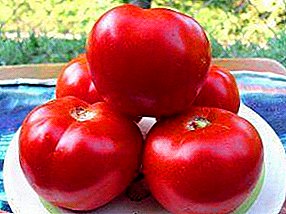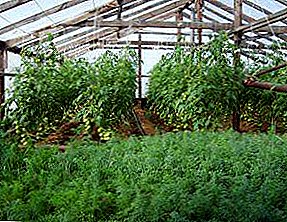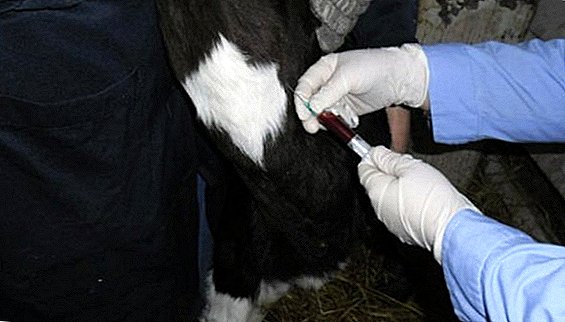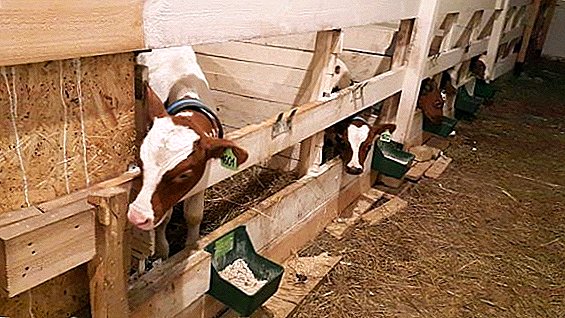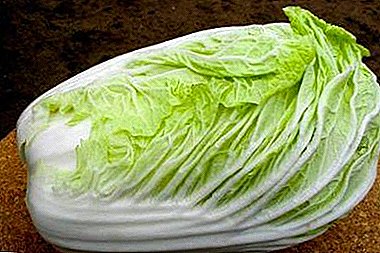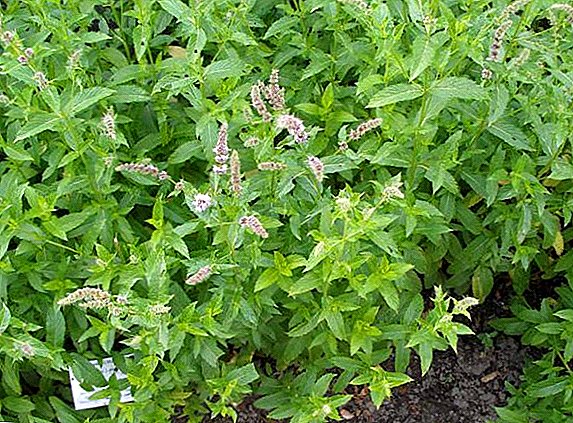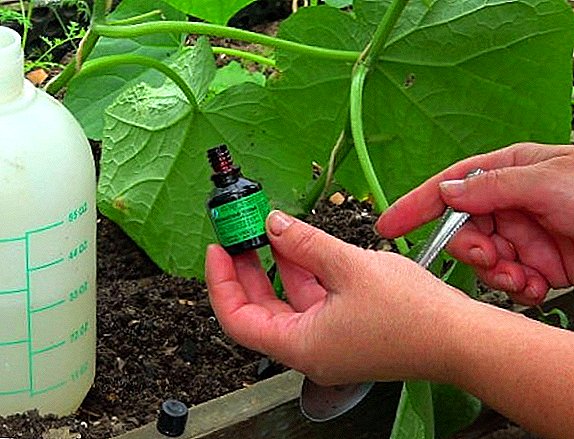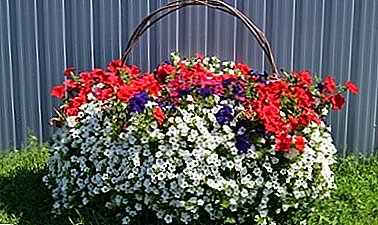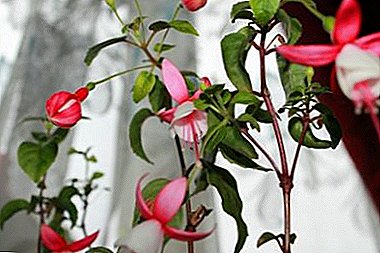
Fuchsia is a genus of perennial plants of the family of Cyprus, including about one hundred species. This plant is known for all its long beautiful flowering, pleasing the eye of flora lovers from the earliest spring to late autumn.
Fuchsia is quite capricious, though not too demanding to care. To achieve stable flowering and flower bush pomp sometimes is not as easy as it may seem at first glance. In this article we will look at such an important process in the life of any plant as transplant. We will get acquainted with favorable conditions for the preservation of health and decorative appearance of fuchsia.
Transplant at home
Pre-recommended pruning plants, removing all dried, old and long shoots, and shortening healthy by a third. Pinching a plant, you can shape its shape at will. For example, to give the appearance of a bush - the shoots are cut after the second pair of leaves, and for growing in a hanging pot or a high pot - after the third.
At the roots of the plant should pay special attention - there should not be mold. If damaged roots are found, they are best cut.
 To begin transplanting should select the appropriate pot. It is best suited with thick walls and made of ceramics - it will allow the root system of the plant not to overheat. You should also pay attention to the color of the pot - light shades reflect sunlight, while dark ones attract it, which is completely undesirable for fuchsia. At the bottom of the tank for transplantation there must be drainage holes.
To begin transplanting should select the appropriate pot. It is best suited with thick walls and made of ceramics - it will allow the root system of the plant not to overheat. You should also pay attention to the color of the pot - light shades reflect sunlight, while dark ones attract it, which is completely undesirable for fuchsia. At the bottom of the tank for transplantation there must be drainage holes.
It is also worth keeping in mind that fuchsia does not tolerate cramped pots.. The root system of the flower should be free to intervene in a new transplant container.
The next important point for proper transplantation is the selection of a suitable soil. A suitable mixture should have a low acidity, the pH value is not more than 6.
The optimal composition:
- three pieces of foliage ground;
- two parts of peat;
- one piece of medium sand.
Be sure to use the drainage, which is suitable for broken brick, small pebbles or expanded clay. The plant does not like stagnant water at the roots. It is better to prepare the soil yourself, since the store soil often contains more peat.. In the summer, it dries quickly in the upper part of the pot, remaining moist from the bottom. Because of this, with abundant watering the plant may die.
Fuchsia will need to ensure high humidity. To do this, you need to carry out frequent spraying in such a way that a moist cloud is formed over the plant. The only important nuance is that large droplets on the leaves should be avoided - a darkening can be formed from them.
The transplanted plant should be placed in a slightly darkened place. Direct sunlight exposure is undesirable for fuchsia.. She likes cool rooms. In the summer, the temperature should not exceed 20 degrees, in the winter - 15. To protect yourself in the summer from excessive stuffiness, you can take the plant pot to a balcony or yard, choosing a place where the sun's rays fall only in the morning.
Water the transplanted fuchsia should be moderate, for this purpose, clean defended water is ideal. After the plant gets used to the new pot, watering should be made more regular.
An important condition is that before irrigation it is necessary to make sure that the soil is dry. Excessive water can cause plant death.. It is also important to produce watering in the morning, before the onset of heat or in the evening after sunset. Alternatively, it is also possible to spray the plant.
Important: When caring for fuchsia, it is important to ensure that there is no water left in the pan. It is harmful to the roots of the plant.
We recommend to watch the video about fuchsia transplantation:
What to choose fertilizers?
 It is not recommended to feed a newly transplanted plant, as well as a sick or weakened one. It could hurt him even more.
It is not recommended to feed a newly transplanted plant, as well as a sick or weakened one. It could hurt him even more.
If the plant is healthy and has already been adapted after transplantation, then you can start feeding. In different phases of growth, fertilizers are different. Young fuchsia likes nitrogen fertilizer. Thanks to them, the flower has a rich green color and grows rapidly.
An adult plant for heavy flowering should be fed with fertilizers containing phosphorus and potassium. Before watering, the concentration of fertilizer is best reduced by five times the recommended one. Fuchsia is also good for organic fertilizers, but it is better to alternate them with mineral ones. Fertilize the plant should be every two weeks.
Pruning a flower in the fall
Autumn - the period of completion of active flowering fuchsia the onset of the rest period. Pruning in this period should be carried out immediately, as soon as the fuchsia ceased to bloom and passed the state of rest. This contributes to a good hibernation and a successful spring awakening.
For this you need:
- Carefully remove the bush from the pot and inspect it for diseases and parasites. Carefully take out the fuchsia in order not to damage the roots that could have grown against the walls of the pot. Old land is better to throw away, as it may be infected with pests.
- Fuchsia should be cleaned from parasitic insects and their eggs. Patients roots, black, with a grayish tint - cut off. Pruning should be pruned, grabbing a healthy root of about a centimeter to prevent re-infection.
- The pot is thoroughly washed and disinfected.
- Next, you should fill the new drainage and fresh soil, which is neatly placed flower.
After all the manipulations, you need to put the fuchsia in a dark, wet and cool place in which the plant will spend the whole winter. This is a very important difference from spring transplantation, when fuchsia is left warm. In autumn and winter, the plant should rest and gain strength before the new growing season..
Do not allow the earthen clod to dry out and periodically water the plant with clean defended water. Feed at this time is not necessary.
Reproduction flowering plants
Abundantly blooming fuchsia can be propagated by green cuttings, seeds and leaves. Consider these methods in more detail.
Cuttings
 If the choice fell on fuchsia grafting, then 5-8 cm stem cuttings are selected for this purpose. They are planted in several pieces in containers with a diameter of about 12 cm. Next, the pots should be placed in a small greenhouse for subsequent germination.
If the choice fell on fuchsia grafting, then 5-8 cm stem cuttings are selected for this purpose. They are planted in several pieces in containers with a diameter of about 12 cm. Next, the pots should be placed in a small greenhouse for subsequent germination.
Often rooted cuttings with water with the addition of activated carbon. The pots are covered with a film on top, occasionally removing it for ventilation. For planting cutting should wait for the formation of roots in the amount of 1.5-2 cm.
We recommend to watch the video about fuchsia grafting:
Seeds
When seeds multiply, fuchsia germinates in about 50 days. since landing. First you need to prepare a suitable soil by mixing peat and sand. A month later, the grown plant should be dive. How to plant sprouts? They are planted in pots of 5-6 pieces, do not forget to pre-pinch the top to improve branching.
Leaves
When breeding with the help of the leaves from the mother plant, the most developed leaves with the stem are removed and planted in soft soil, covered with film on top.
Diseases and pests
The flower has a fairly good immunity, but there are few pests that can cause problems for gardeners:
- White fly - This is a small insect often striking plants located on the balconies. The main feature - whitish bloom on the leaves. With a strong defeat, they turn yellow and fall off. Cure can be washed with soapy water, but this will only help if the fuchsia is still green. If the defeat went further, then only chemical treatment with special preparations will cope.
- Spider mite - affects the plant with dry and warm air. A sign of infection is yellowness on the leaf and a yellowish gray patina on the underside. To prevent infection by this pest in hot weather, you should spray the plant regularly.
The causes of other diseases are often improper care and inadequate nutrition. So with excessive wetting of the soil, powdery mildew appears, and when there is a shortage of manganese - yellowing of the leaf veins.
Conclusion
Fuchsia attracts many with its decorative properties. However, to get a flowering fuchsia, you should know all the features of its cultivation. What matters is not only the correctly chosen pot and soil, but also the creation of favorable conditions for the growth and development of the flower. Only in compliance with all these factors together will allow you to get a healthy and beautiful plant with a decorative look.


